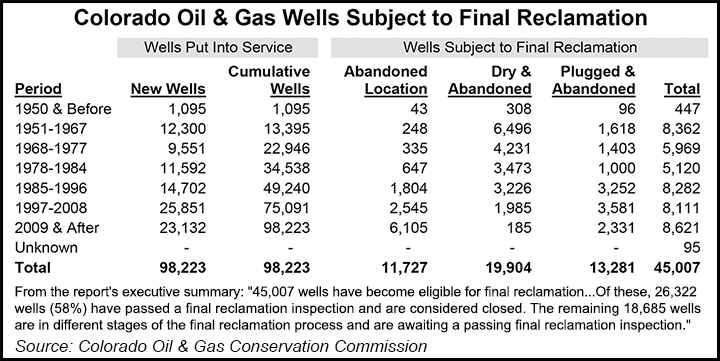Regulatory | NGI All News Access
Colorado Targeting Unused NatGas Well Reclamation
The Colorado Oil and Gas Conservation Commission (COGCC) has identified thousands of idled well locations it will be focusing on in 2016, according to a 43-page report, “Final Reclamation Inspection and Implementation Program,” completed by COGCC staff.

Falling commodity prices that stalled natural gas development in western Colorado in 2008 have contributed to a growing collection of unused wells, according to the report. More than 40% of the state’s wells (45,000 of 98,000) are eligible for final reclamation, with more than half of those having passed final reclamation inspections.
This year, COGCC will concentrate on inspecting the remaining nearly 19,000 wells eligible for final reclamation. The state agency has added four reclamation inspectors to its staff in the past year to handle the backlog.
“The remaining 18,685 wells are in different stages of the final reclamation process and are awaiting a passing final reclamation inspection,” the staff report concludes, adding recommendations on steps to “prioritize final reclamation inspections for these wells.”
Saying that Colorado “significantly revised” its reclamation rules in 1996 and again in 2008, COGCC staff completed a comparative analysis of its reclamation rules with other states’ rules, the rules in the Colorado Division of Reclamation, Mining and Safety, and the U.S. Bureau of Land Management.
COGCC staff concluded that “the commission’s rules are comparatively rigorous and comprehensive.” The staff recommended only minor clarifications of a few rules, adding that the existing rules are “robust and sufficient.”
COGCC staff believe the reclamation inspection process can be made more efficient and effective by deploying database reports and geographic information systems as tools.
In addition, the staff report recommended three other actions:
The latest blueprint for the reclamation work is an outgrowth of hearings held last May by the COGCC, which directed staff to complete a census of the wells and locations, evaluate the state’s current rules and make final recommendations. One of the ultimate products of the effort will be an electronic database of well status information that the staff has begun.
Poor data quality and a lack of regulatory and policy clarity were found to be two weaknesses; strengths include the state’s field inspection structure, reclamation staff expertise and collaboration with other work units by the field inspection unit.
Among the “threats” identified in the report are the “ambiguity of some reclamation rules,” which are “subject to differing interpretations by the regulator and regulated community.”
© 2024 Natural Gas Intelligence. All rights reserved.
ISSN © 1532-1231 | ISSN © 2577-9877 |
